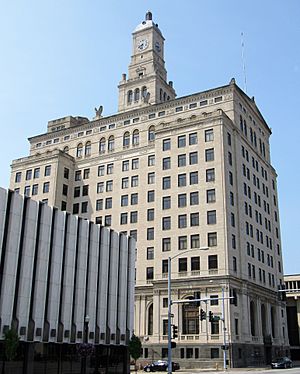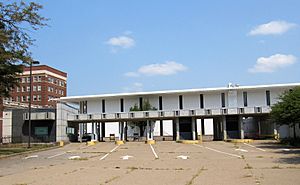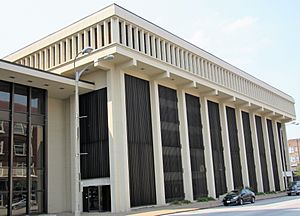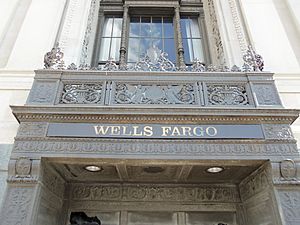Davenport Bank and Trust facts for kids
|
Davenport Bank and Trust
|
|
|
U.S. Historic district
Contributing property |
|
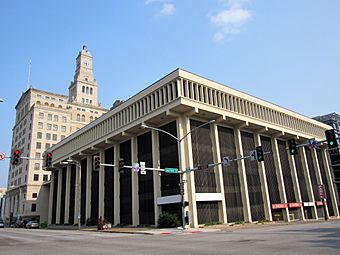 |
|
| Location | 201-209 W. 3rd St. Davenport, Iowa |
|---|---|
| Area | 1.1 acres (0.45 ha) |
| Built | 1927, 1971 |
| Architect | Weary & Alford Company Richard C. Rich & Associates |
| Architectural style | Classical Revival Modern Movement |
| Part of | Davenport Downtown Commercial Historic District (ID100005546) |
| MPS | Davenport MRA |
| NRHP reference No. | 83002395 (original) 16000249 (increase) |
Quick facts for kids Significant dates |
|
| Added to NRHP | July 7, 1983 |
| Boundary increase | May 12, 2016 |
The Davenport Bank and Trust building was once home to a very important bank. For most of the 1900s, it was the main bank in the Quad Cities area. It was even Iowa's biggest commercial bank for a time. The building itself has been a tall landmark in downtown Davenport, Iowa since it was built in 1927.
In 1993, a bank called Norwest Bank bought Davenport Bank. Later, in 1998, Norwest Bank joined with Wells Fargo. Now, the building is known as Davenport Bank Apartments. It has been changed into a place with businesses, offices, and homes. It is still the tallest building in the Quad Cities. The building was added to the National Register of Historic Places in 1983.
History of the Bank Building
The bank started in 1869 as German Savings Bank. Henry Lischer and H.H. Anderson created it. Davenport had many German families, and they helped the bank grow. By the 1890s, Davenport was a major money center for the state.
German Savings Bank grew by taking over other banks. It became the largest bank in Iowa by 1916. During World War I, people had strong feelings against Germany. So, in 1918, the bank changed its name to American Commercial and Savings Bank.
In the early 1920s, Davenport had 11 banks. American Commercial and Savings Bank continued to grow. They built this impressive new building in 1927. It showed how important the bank was to the community. The building has been a key part of the city's skyline ever since.
During the Great Depression in the 1930s, many banks struggled. American Commercial and Savings Bank took over more banks. When President Franklin Roosevelt signed the Emergency Banking Act in 1933, only five banks in Davenport were still open. This bank was one of only two that reopened in Davenport.
At this time, the bank changed its name to Davenport Bank and Trust Company. E.P. Adler was in charge. By 1936, it had become the second largest bank in Iowa.
V.O. Figge joined the bank in 1931. He helped the bank grow a lot. In 1960, the bank's money grew to $100 million. This made it the state's largest bank again. In 1966, Davenport Bank added a modern drive-in banking area. In 1971, a new parking garage and more bank space were built next to the main building.
In 1993, Norwest Bank bought Davenport Bank & Trust. Then, in 1998, Norwest Bank merged with Wells Fargo. In 2005, a company bought the building. In 2013, parts of the building were turned into 29 apartments. Wells Fargo Bank stayed in the building until 2016. Then, the building was renamed Davenport Bank Apartments.
Building Design
The main bank building was designed by a Chicago company called Weary & Alford Company. It was built between 1926 and 1927. The building is twelve stories tall. It has a strong steel frame covered with limestone.
The bottom part of the building has black marble. It also has fancy metal doors and columns. The middle part looks like a regular office building with smooth limestone. The top of the building has a special temple-like design and a three-story clock tower. Four large eagle statues, each 6-foot (1.8 m) tall, sit on the corners of the tower. The clock faces are 10 feet (3.0 m) wide. The building is 255 feet (78 m) tall, making it the tallest in the Quad City area.
The main banking room inside is very grand. It has a high, painted ceiling. Large arched windows let in a lot of light. The ceiling has a colorful design with curved sections. A painting by a local artist, Hiram Thompsen, hangs on one wall. It shows the signing of a treaty after the Black Hawk War. This painting has been there since 1928. The original metal teller "cages" are still there, and the inside has dark wood and marble.
The six-story parking garage was designed by Richard C. Rich & Associates. It has five floors for parking, with 250 spaces. The top floor used to be office space. The garage is made of concrete and aluminum. A round ramp in the middle lets cars reach all parking levels. A three-story walkway connects the garage to the main bank building.
Art Inside the Bank
The beautiful ceiling in the main banking room was designed by Chicago artist Alexander Rinoskopf. Local artists helped create it. Ten men made the stencils on 85 yards (78 m) of paper. Two artists then painted the designs. The style is like the Italian Renaissance. It features spirals, flower shapes, festoons (hanging decorations), griffins, swans, and masks.
There are also ten murals, each 6 feet (2 m) high. These paintings show the history of Davenport from its earliest days up to the American Civil War. They show things like:
- The first Europeans arriving near the Mississippi River (1654).
- The Sauk warrior Black Hawk (1812).
- A battle on Davenport's Credit Island during the War of 1812 (1814).
- The last bison being chased from the Quad Cities area (1816).
- The building of Fort Armstrong on Arsenal Island (1817).
- The first steamboat going up the Mississippi River (1823).
- Davenport being founded and people moving there (1836).
- Davenport's first school (1838).
- The first railroad bridge across the Mississippi River (1856).
- Civil War training camps in Davenport (1861).
The largest mural is on the south wall. It shows the signing of the Black Hawk Treaty in September 1832. This treaty was signed in Davenport. Hiram Thompsen, who painted it, was from Cincinnati. He studied art in Chicago. The painting is 15 by 9 feet (5 by 3 m) large. It shows important people like General Winfield Scott, his interpreter and Davenport founder Antoine LeClaire, and Native American chiefs Keokuk and Pashapaho.




